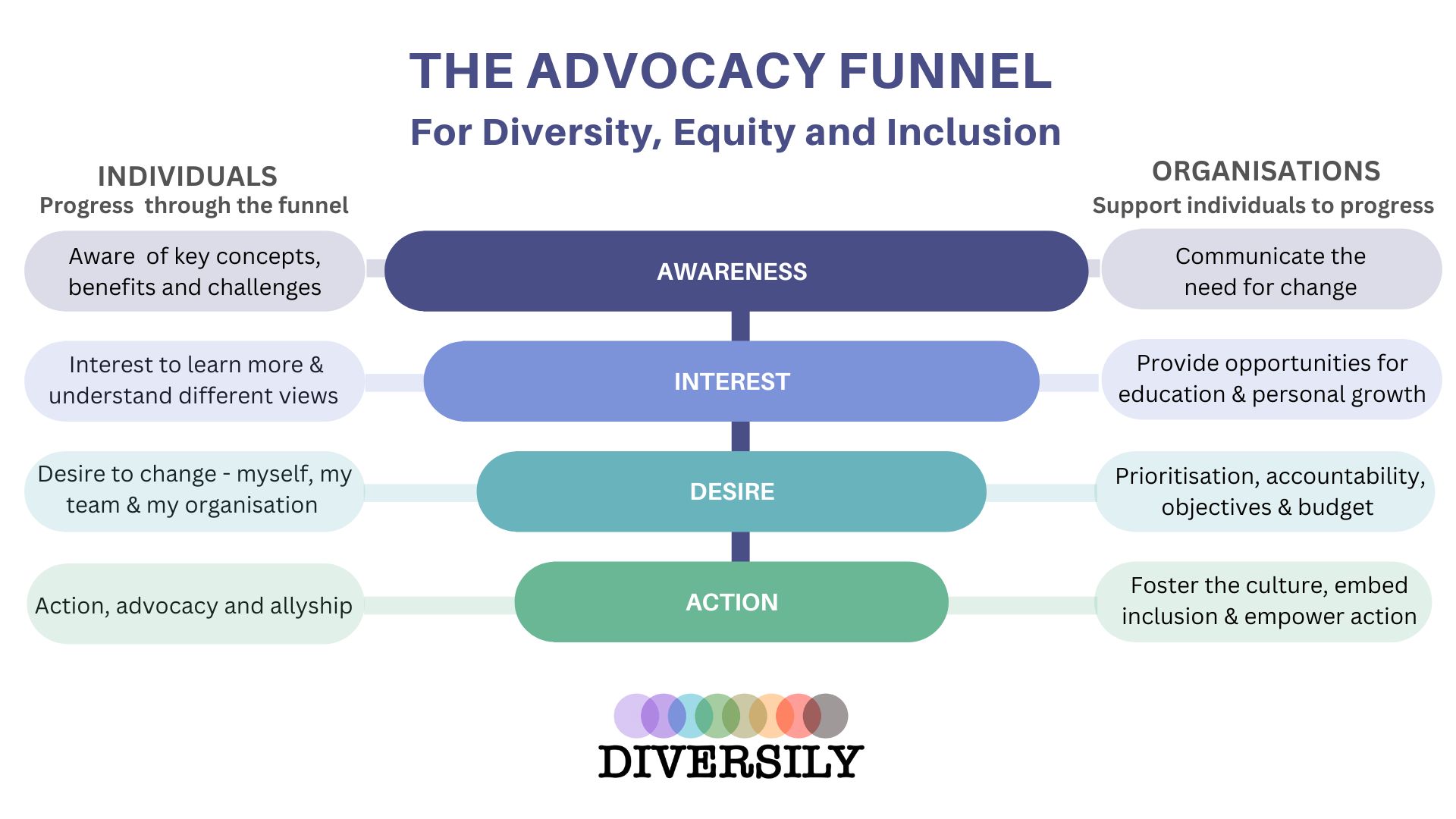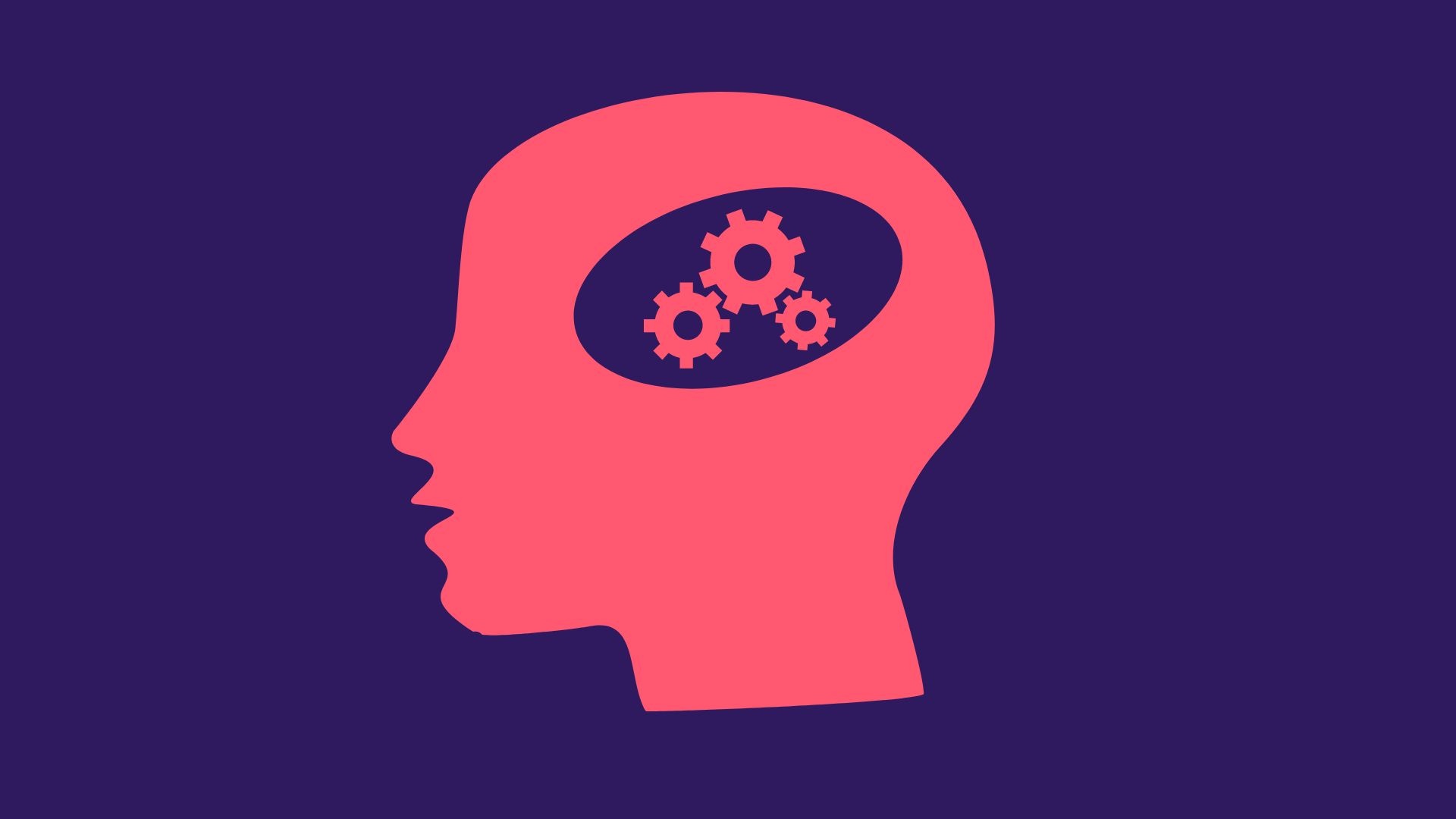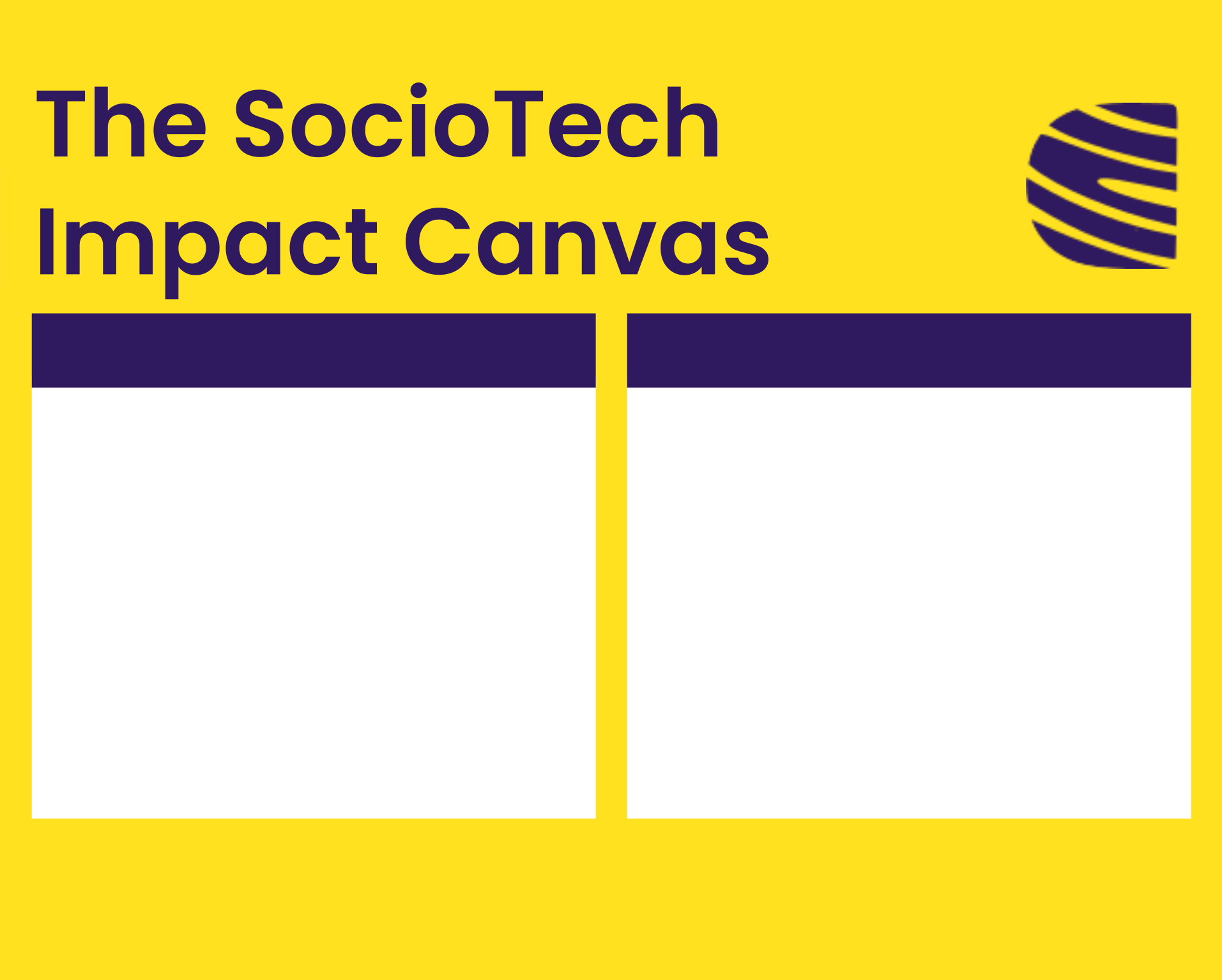Diversity, equity and inclusion (DEI) is no longer a nice to have. It is a critical lever for business success, that needs to be measured and managed. If you are interested in exploring why diversity, equity and inclusion matters, start with this article that explores the need to take a more human centre purpose led approach to business.
Many organisations have made great strides in measuring diversity of their staff (across multiple dimensions) and how included their staff feel. However, this is only half of the picture.
Diversity, equity and inclusion (DEI) is not passive; it is active.
Organisations need to measure not just the diversity of their people, equity of experience and sense of inclusion, but also how active they are in contributing to DEI outcomes and creating an inclusive culture.
Increasingly people are claiming to be advocates for DEI but are not taking any proactive action or demonstrating inclusive behaviour. To continue to progress on our collective journey we need to get better at measuring authentic action.
In this article we’ll explore:
The truth about diversity, equity and inclusion
Creating an authentically diverse, equitable and inclusive organisation, goes beyond compliance or tokenism.
Progress can only be achieved when everyone is actively involved. DEI is not solely the responsibility of one person or department. It should be considered as a collective effort, woven into the fabric of an organisation’s values, objectives and strategic decisions. It is also a continuous journey that requires ongoing learning, self-reflection, and growth.
The truth about DEI (Diversity, Equity, and Inclusion) is that progress requires everyone to play an active role. It is not just an extracurricular or sideline activity, nor the responsibility of a single DEI lead, but rather an integral part of every individual’s day-to-day.
While it may be idealistic to expect that everyone will actively participate on a daily basis, creating an inclusive culture necessitates everyday interactions where individuals feel safe to be authentic, speak up, and challenge one another. It is the small actions and words that make a big difference. It requires being allies, actively seeking and valuing different perspectives, and recognising that neutrality is complicit with the current biased status quo.
Research consistently demonstrates that diversity and inclusion are not only moral imperatives but also beneficial for business success. As businesses, we should expect our people to actively contribute to creating these outcomes. Creating an inclusive culture requires a collective effort, where everyone takes ownership and accountability. It means challenging our own biases, being open to uncomfortable conversations, and continuously learning and evolving. It requires leaders to set the tone from the top, but it is not solely their responsibility. Each individual within the organisation has the power to make a difference, to create a workplace where everyone feels valued, respected, and included.
This raises some critical questions for business leaders:
- What specifically do we expect of all staff?
- What is our approach to ‘naysayers’ or those who do not exhibit inclusive behaviours?
- How do we create accountability for DEI across our business?
The answers to these questions will vary by organisation based on a number of factors such as DEI maturity and aspirations, culture, current practices, size and available resources.
Businesses just starting out on their diversity and inclusion journey will not be ready for this deeper and more meaningful challenge. They will still be grappling with the ‘why change?’ and ‘what does it mean for us?’ and ‘what are the quick wins or essential steps to kick start our journey’.
Measuring Success
When we realise that DEI is about active participation, we see that current approaches to measuring DEI are not sufficient.
Measuring diversity, equity and inclusion is still a relatively new practice for organisations. Introduction of the Equality Act in 2010 and gender pay gap reporting requirements in 2017 in the UK have driven increased scrutiny in this area. To varying degrees, organisations have measured diversity, inclusion and equity.
- Diversity metrics refer to the measurement of the representation of different groups. This includes demographic data such as race, gender, age, and disabilities.
- Inclusion metrics focus on the experiences and attitudes of individuals within different groups. This includes measures of engagement, satisfaction, and sense of belonging.
- Equity metrics go beyond diversity and inclusion, evaluating whether diverse individuals have equal opportunities, treatment, and outcomes. This includes measures of access, impact, and outcomes for underrepresented groups and help to identify and address systemic barriers and inequalities for all.
DEI (Diversity, Equity, and Inclusion) is a complex system, where there may not always be a direct correlation between input and outcome. While starting with outcome metrics such as the diversity of our staff and employee sense of inclusion is important, it is equally crucial to understand that these numbers alone may not provide a comprehensive picture.
Often, organisations find that despite their efforts, these diversity and inclusion metrics stagnate or show limited progress. To gain a deeper understanding of the situation, it becomes necessary to measure the collective effort being put into driving these outcomes. This can help us to identify where progress is being made, where challenges persist, and where there may be gaps or areas for improvement. It allows us to assess the effectiveness of our initiatives, identify barriers or systemic issues, and make informed decisions on where to focus our efforts.
Measuring the collective effort also recognizes that DEI is not the sole responsibility of a few individuals or departments, but rather a shared commitment across the organisation. It requires a cultural shift where every individual understands the importance of diversity, equity, and inclusion and actively contributes to fostering an inclusive environment.
By examining both the outcome metrics and the collective effort, organisations can gain a more holistic understanding of their progress in driving DEI. It helps us move beyond surface-level measures and provides valuable insights on how to drive meaningful change. It allows us to continually assess, adjust, and refine our strategies and initiatives to create a more diverse, equitable, and inclusive workplace for all.
DEI is an ongoing journey, and the measurements we use should evolve as we deepen our understanding and commitment to fostering a truly inclusive organisation.
The DEI Journey
It is quite common to think of DEI as a journey. Various maturity models for both organisations and individuals have been established by experts in the field. For example The Five Stage of DEI Maturity identifies the typical stages an organisation moves through from awareness to sustainable best in class ongoing action.
The piece of the puzzle that is often missing is measuring how active or passive everyone within the organisation is in contributing to supporting the organisation to progress on its DEI journey.
The organisational maturity and individual maturity is of course connected. Some individuals may be very active advocates for DEI, despite low organisational maturity or intervention. This is often motivated by personal experiences. The more an organisation does to support its people to progress on their DEI journey, the further along its people will be.
For small organisations, without big budgets, the advantage lies in their ability to be nimble and agile in shaping their culture. It is an opportunity to double down on their core values, align them with DEI principles, and embed them into everyday behaviour, discussions and decisions.
On the other hand, larger organisations face the challenge of scaling behaviors and good practices across a larger workforce. It requires a strategic approach to ensure that DEI becomes ingrained in the organisation’s DNA. This may involve providing comprehensive training programs, establishing clear policies and guidelines, and fostering accountability at all levels. It also entails creating platforms and spaces for open dialogue, collaboration, and the sharing of best practices.
Regardless of size, what is clear is that intentional effort is needed by the organisation in order to support it’s people to become more active advocates for DEI.
Moving people to act
In today’s polarized world, it is unrealistic to expect that everyone will be personally deeply motivated to advocate for diversity and inclusion. However, when a business clearly states diversity and inclusion as a goal, and sets expectations for the behaviour that is expected of everyone to foster an inclusive culture, something remarkable can happen.
When it is understood that diversity and inclusion drive performance and success, and when individuals see how it aligns with their personal and professional growth, they become motivated to actively engage in promoting diversity and inclusion. By establishing a culture where inclusive behaviours are not just encouraged but expected, organisations create an environment where individuals are driven to embrace diversity and inclusion as a means to their own success and the overall success of the business.
Inspiring people to take action is not a new discipline. This is in fact what marketing is all about.
So what can we learn from marketing to help drive forward DEI?
In 1898, Elias Elmo Lewis created a formula that changed marketing forever.
“Attract attention, maintain interest, create desire, get action.”
This AIDA model became the well known marketing funnel.
Thinking in funnels is great way to break down goals into different stages, especially when they reflect a maturity journey. Funnels can be used to improve the conversion at each stage to achieve the best possible outcomes.
The Advocacy Funnel
Inspired by the marketing AIDA funnel The Diversily Advocacy Funnel can provide a simple framework for thinking about how to engage more people to become DEI advocates. Organisations can measure the proportion of people at each stage of the funnel and how active they are in contributing to DEI outcomes.

The progression through the DEI advocacy funnel is a journey of growth and engagement, with each stage building upon the previous one to create meaningful change.
It reflects the interdependence between the organisation and individuals. The focus of the funnel is to show the evolution of individuals as they become advocates for inclusive change. It also shows what the organisation needs to do at each stage to enable people to progress.
For example if the organisation does not provide training and development opportunities, fewer people, who are not motivated by personal experience, will progress through to the desire stage. Similarly if the culture of the organisation does not make people feel psychologically safe, even if they desire change, they will not act as allies and speak up in difficult situations.
Measuring active participation
It is crucial to recognise and measure people’s active participation in taking action and being advocates for change. Meaningful progress in DEI cannot be achieved through passive bystanders or mere lip service—it requires individuals to actively engage, challenge the status quo, and champion inclusivity in all aspects of their work.
Measuring people’s active participation can involve various elements, such as:
Education and Growth: Recognising individuals’ commitment to personal growth and learning in the field of DEI. This could involve participation in relevant training programs, staying informed about emerging best practices, and actively seeking opportunities to expand their knowledge and understanding.
Collaboration and Allyship: Assessing individuals’ ability to collaborate effectively across diverse teams, support and uplift colleagues from underrepresented backgrounds, and actively foster an inclusive work environment through allyship.
Advocacy and Influence: Evaluating individuals’ efforts to be vocal advocates for change within the organisation. This includes speaking up against discriminatory practices, amplifying underrepresented voices, and using their influence to drive systemic shifts towards greater equity and inclusion.
Practice and Process: Assessing the extent to which individuals take tangible steps to improve DEI, such as participating in diversity-related projects, volunteering for inclusive initiatives, or actively seeking opportunities to address biases and inequities through behaviour, process or policy changes.
A framework for DEI advocacy
The Diversily Advocacy Funnel can provide a framework for understanding and assessing the behaviour change required to drive diversity, equity, and inclusion. Here’s what to focus on at each stage:
- Awareness: Measure the reach, visibility and extent to which DEI communication and content is being disseminated and capturing attention.
- Interest: Assess the level of interest and engagement in DEI education, discussion and personal growth opportunities.
- Desire: Measure the desire for change, at both the organisational and individual level, and the influence of DEI advocacy on attitudes and perceptions.
- Action: Measure the tangible actions and behavioural change, taken by individuals and the organisation to drive DEI.
The Advocacy Funnel can help you gain a comprehensive understanding of the impact of your organisations collective advocacy efforts. It also demonstrates the interplay between what is required from both the organisation and the individuals within it at each stage. It highlights the importance of not only raising awareness and generating interest but also fostering a desire for change and driving concrete actions that lead to meaningful progress and long lasting impact.
Example metrics
Let’s explore example metrics that can be used at each stage of the advocacy funnel.
The idea is not to implement all possible metrics. Start simple. Pick the key metrics that are most meaningful for your organisation. Contact Diversily if you’d like help doing this.
The idea is to establish metrics, to suit your organisation to provide an indicator of the proportion of staff at each stage of the funnel. This will in turn require action by the organisation to support staff at each stage. For example you can’t measure read rates on educational content or attendance at events if the organisation is not sharing the content or putting on the events in the first place.
The advocacy funnel is not for organisations wishing to pay lip service to diversity and inclusion, but for those who are willing to take authentic action.
Awareness metrics
The Awareness stage of the funnel is about raising awareness of the positive impact of diversity, equity, and inclusion on business success.
To understand the proportion of staff at the Awareness stage you might measure:
- Read rates of DEI-related topics covered in internal communications, such as newsletters, intranet articles, or blog posts.
- Participation in employee onboarding or orientation programs that include DEI topics.
- Feedback or survey responses indicating increased awareness or understanding of DEI concepts, benefits and challenges.
- Scores in a DEI foundations quiz.
- Exposure to DEI topics and discussions in everyday business activities, such as project meetings, team meetings, town halls or strategic planning sessions.
Awareness metrics provide insights into the extent to which staff are exposed to DEI topics and these being discussed within the organisational culture and day-to-day operations. By measuring these awareness metrics, organisations can assess the level of knowledge, understanding, and exposure to DEI principles among their employees, creating a foundation for further engagement, education and action.
Interest metrics
Awareness does not necessarily mean agreement or interest. The Interest stage of the funnel is about engaging people to want to learn more. People who progress from the awareness stage to the interest stage want to understand what DEI means for them. They want to explore their own beliefs, privileges, biases, and better understand the experiences of others. They are open to being challenged, forming their views and building their knowledge.
Organisations need to provide opportunities for education and personal growth. Organisations that instil a growth mindset in their staff and create a learning culture are more likely to inspire their staff to progress from the awareness to the interest stage.
To understand the proportion of staff at the Interest stage you might measure:
- Engagement with education and growth opportunities provided.
- Attendance at optional DEI-focused training sessions, workshops, and events.
- Engagement with educational content such as webinars, podcasts, articles, or e-learning modules that cover DEI topics.
- Active participation in discussions and forums centred around diversity, equity, and inclusion.
Interest metrics provide valuable insights into the engagement and receptiveness of employees towards DEI. These metrics go beyond mere awareness and demonstrate the genuine curiosity, willingness, and active involvement of individuals in learning, participating, and consuming DEI-related content, training, workshops, and events.
It is worth noting that measuring participation of staff at mandatory DEI training does not measure interest, as participants are not engaging because they want to, but rather because they have been told to.
Interest metrics can help organisations to tailor their initiatives to better meet the needs and preferences of their employees and foster a culture of continuous learning, which lays the foundation for meaningful change.
Desire metrics
Some people may feel threatened by DEI initiatives or do not see equity as an ultimate goal. Levelling up unequal power structures or removing systemic bias is not perceived as advantageous for all. The Desire stage of the funnel is about moving people to want change. This needs to be backed by a genuine organisational commitment for change. This requires prioritisation of DEI, connection to core values and strategic priorities and provision of sufficient budget and resources. It also requires leadership commitment and manager’s endorsement or encouragement of DEI related discussion, action and initiatives.
Individual’s desire for change often comes from personal experience of inequity, bias or discrimination. It is also fuelled by people who feel a deep sense of responsibility to create a more just and fair world.
Diversity fatigue is real. It is important to realise that people can move backwards as well as forwards in their level of motivation to drive DEI.
To understand the proportion of staff at the Desire stage you might measure:
- Surveys, feedback mechanisms, or sentiment analysis that provide insights into employees’ desires for a more inclusive and equitable work environment.
- Commitments staff members have made to drive change.
Desire metrics are valuable in assessing individual support for diversity, equity, and inclusion. These metrics provide insights into the willingness and motivation of employees at all levels to actively participate in driving change, advocating for DEI, and creating an inclusive work environment.
Action metrics
At the heart of The Advocacy Funnel lies the stage of action, when DEI becomes embedded and individuals actively contribute to DEI outcomes.
To understand the proportion of staff at the Action stage you might measure the number of individuals who have taken tangible steps, such as:
- Voluntary participation in DEI projects, initiatives, or task forces.
- Engagement with employee resource groups (ERGs) focused on different dimensions of diversity.
- Instances of individuals advocating for and implementing inclusive practices in their teams or departments.
- Efforts to make products and services more inclusive.
- Instances of people speaking up against bias or micro aggressions.
- Participation in external activities such as volunteering for DEI-related organisations or engaging in community initiatives.
- Evidence of individuals sharing knowledge, resources, or insights to promote DEI awareness and education.
- Demonstration of inclusive behaviour or allyship.
- Adding DEI-related content in organisational documents, policies, or guidelines.
You may also measure the extent to which people feel safe to express dissenting views. Without this, advocacy and inclusion are not possible.
Action metrics showcase the extent to which individuals have transformed their awareness and desire into meaningful action, becoming catalysts for change.
Increasingly people are claiming to be advocates for DEI but are not taking any proactive action or demonstrating inclusive behaviour. Action metrics should highlight evidence of ongoing action.
The Advocacy Funnel enables you to categorise staff by each stage of the funnel. Monitoring this over time can help you gauge the effectiveness of your interventions and celebrate the collective progress you are making.
Benefits
The Diversily Advocacy Funnel offers numerous benefits in driving change and fostering a more inclusive environment. Here are some key points to consider:
Recognition of Similarities: The Advocacy Funnel acknowledges the parallels between DEI and marketing, emphasising the need to gain attention and inspire action. This provides an opportunity to apply well understood practices in a different domain.
Measurement and Engagement: Unlike traditional employee engagement surveys that focus on individuals as recipients of DEI efforts, the Advocacy Funnel considers employees as active participants responsible for driving change.
Targeted Intervention: The funnel model allows for targeted efforts based on individuals’ stage in the DEI journey. Personal development and education are vital for those in the interest stage, while guidance and support are necessary for those in the action stage to sustain their energy and participation.
Normalising the Journey: Recognising that everyone progresses at their own pace, the funnel model normalises the DEI journey and provides a framework for managing and supporting individuals at different stages.
Clarifies Expectations: Implementing the Advocacy Funnel forces the organisation to think about the intentional support it will provide to support individuals on this journey, as well as gain clarity on exactly what is expected from all staff members.
Measuring Effectiveness: By using the DEI funnel, organisations can assess the impact of their interventions and measure progress. It offers a standardised approach to evaluating the effectiveness across various initiatives.
Simplicity and Flexibility: Implementing the DEI funnel doesn’t have to complicated. You can start with a simple anonymous, employee pulse survey that is carefully crafted to provide an indication of the stage people are at, specific action that is being taken and further support required from the organisation. This can be conducted periodically to monitor changes over time. You can tailor for your organisation and extend over time to include additional insights.
Utilising the Advocacy Funnel in DEI efforts enables organisations to better understand and support employees’ progression, measure the impact of interventions, and foster a culture of inclusivity and advocacy.
If you don’t measure it, you can’t manage it.
Don’t leave it to chance or work purely based on intuition.
Think in funnels to achieve better outcomes.
Contact Diversily if you’d like a helping hand to implement meaningful DEI metrics within your organisation. We can help you define your approach, review your results or can offer an independent ‘done for you’ service to implement the advocacy funnel.





